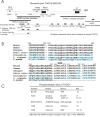THOC5, a member of the mRNA export complex: a novel link between mRNA export machinery and signal transduction pathways in cell proliferation and differentiation
- PMID: 24410813
- PMCID: PMC3899923
- DOI: 10.1186/1478-811X-12-3
THOC5, a member of the mRNA export complex: a novel link between mRNA export machinery and signal transduction pathways in cell proliferation and differentiation
Abstract
Cell growth, differentiation, and commitment to a restricted lineage are guided by a timely expressed set of growth factor/cytokine receptors and their down-stream transcription factor genes. Transcriptional control mechanisms of gene expression during differentiation have been mainly studied by focusing on the cis- and trans-elements in promoters however, the role of mRNA export machinery during differentiation has not been adequately examined. THO (Suppressors of the transcriptional defects of hpr1 delta by overexpression) complex 5 (THOC5) is a member of THO complex which is a subcomplex of the transcription/export complex (TREX). THOC5 is evolutionarily conserved in higher eukaryotes, however the exact roles of THOC5 in transcription and mRNA export are still unclear. In this review, we focus on recently uncovered aspects of the role of THOC5 in signal transduction induced by extracellular stimuli. THOC5 is phosphorylated by several protein kinases at multiple residues upon extracellular stimuli. These include stimulation with growth factors/cytokines/chemokines, or DNA damage reagents. Furthermore, THOC5 is a substrate for several oncogenic tyrosine kinases, suggesting that THOC5 may be involved in cancer development. Recent THOC5 knockout mouse data reveal that THOC5 is an essential element in the maintenance of stem cells and growth factor/cytokine-mediated differentiation/proliferation. Furthermore, depletion of THOC5 influences less than 1% of total mRNA export in the steady state, however it influences more than 90% of growth factor/cytokine induced genes. THOC5, thereby contributes to the 3' processing and/or export of immediate-early genes induced by extracellular stimuli. These studies bring new insight into the link between the mRNA export complex and immediate-early gene response. The data from these studies also suggest that THOC5 may be a useful tool for studying stem cell biology, for modifying the differentiation processes and for cancer therapy.
Figures




References
Publication types
MeSH terms
Substances
LinkOut - more resources
Full Text Sources
Other Literature Sources

